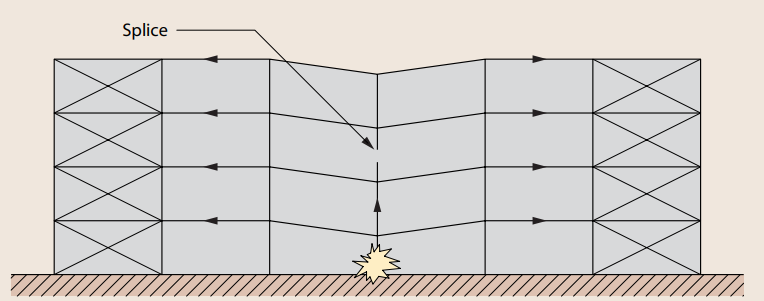Steel Robustness and Disproportionate collapse regulations
Table of Contents
What is Disproportionate Collapse?
Disproportionate collapse refers to a situation where a structure collapses due to an unexpected event, causing damage that is much greater than the original cause. This type of collapse is considered disproportionate because the damage is not proportional to the size or intensity of the event that triggered it.
In building design, the concept of disproportionate collapse is particularly relevant when it comes to designing structures that are critical to public safety, such as high-rise buildings, bridges, and tunnels. The purpose of designing for disproportionate collapse is to ensure that if a structure is subjected to an unexpected event, such as a fire, explosion, or impact, the damage will be contained and not result in a complete and catastrophic collapse of the entire structure.
In the UK, the design of structures to prevent disproportionate collapse is governed by British Standards (BS), specifically BS5950-1:2000 and BS8110-1:1997. These standards provide guidelines and requirements for structural engineers to follow when designing structures to resist disproportionate collapse.
The standards require that structures be designed to withstand specific levels of loading and that they be capable of maintaining their stability and load-carrying capacity after an event that would otherwise cause collapse. For example, BS5950-1:2000 requires that structural elements be designed to withstand the effects of fire for a specified period of time, typically 60 minutes. BS8110-1:1997 provides detailed guidance on the design of reinforced concrete structures, including requirements for structural elements to be designed to resist unexpected loads, such as explosions or impact.
When designing for disproportionate collapse, structural engineers must consider a wide range of factors, including the type of structure, the type of construction materials used, the type and intensity of the event that could trigger collapse, and the potential consequences of collapse. For example, when designing a high-rise building, engineers must consider the potential effects of fire, earthquakes, wind, and other natural disasters.
In addition to the standards outlined in BS5950-1:2000 and BS8110-1:1997, engineers must also consider other relevant building codes and regulations, such as the Building Regulations Approved Document A, which provides guidance on the design of structures to resist accidental damage. This document covers a wide range of topics, including the design of structures to resist fire, explosion, impact, and other events that could cause disproportionate collapse.
In conclusion, the concept of disproportionate collapse is critical to ensuring public safety in the design of structures. The British Standards (BS), specifically BS5950-1:2000 and BS8110-1:1997, provide guidelines and requirements for structural engineers to follow when designing structures to resist disproportionate collapse. When designing for disproportionate collapse, engineers must consider a wide range of factors and ensure that the structures they design are capable of maintaining their stability and load-carrying capacity even in the event of an unexpected event.

What are building categories for disproportionate collapse in the UK?
In the UK, building categories for disproportionate collapse are defined by the Building Regulations Approved Document A. These categories are used to determine the level of resistance to disproportionate collapse required for a building, based on its use, size, and height. The categories are as follows:
Category 1: buildings where life would be endangered if the building collapsed, such as hospitals, schools, and residential care homes.
Category 2: buildings that are not in Category 1 but where there would be significant harm to people outside the building if it collapsed, such as shops, offices, and libraries.
Category 3: buildings that are not in Categories 1 or 2 but where the collapse of the building would cause harm to other property, such as warehouses, industrial buildings, and car parks.
The specific requirements for each category are detailed in the Building Regulations Approved Document A, which sets out the criteria for assessing the risk of disproportionate collapse, the minimum levels of resistance required, and the methods of assessment. The requirements are based on the size and height of the building, the number of storeys, and the use of the building. For example, Category 1 buildings are required to have a higher level of resistance to disproportionate collapse than Category 3 buildings.
It’s important to note that these categories and requirements are subject to change and updates over time, so it is advisable for structural engineers and building designers to stay up-to-date with the latest guidelines and regulations.
